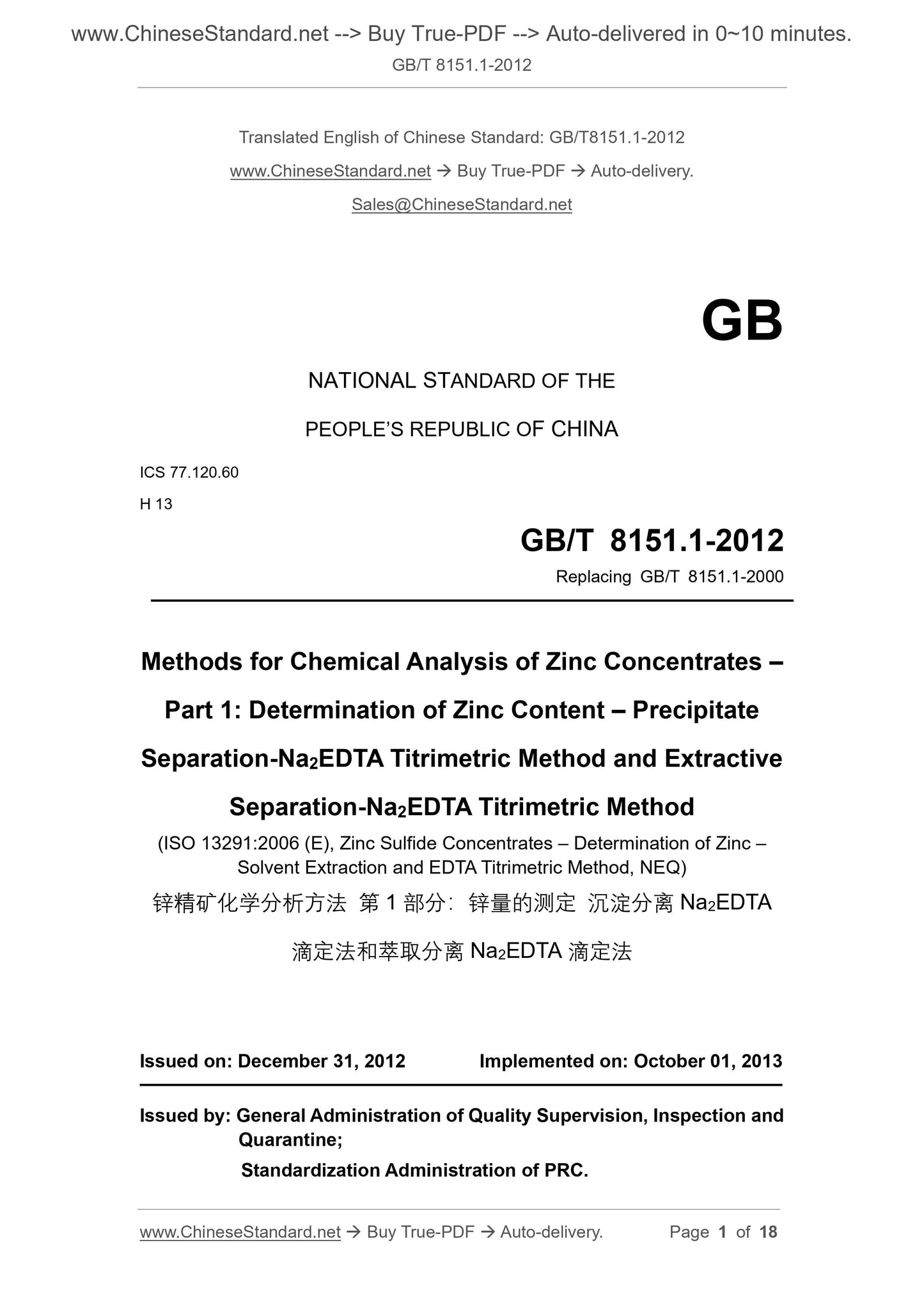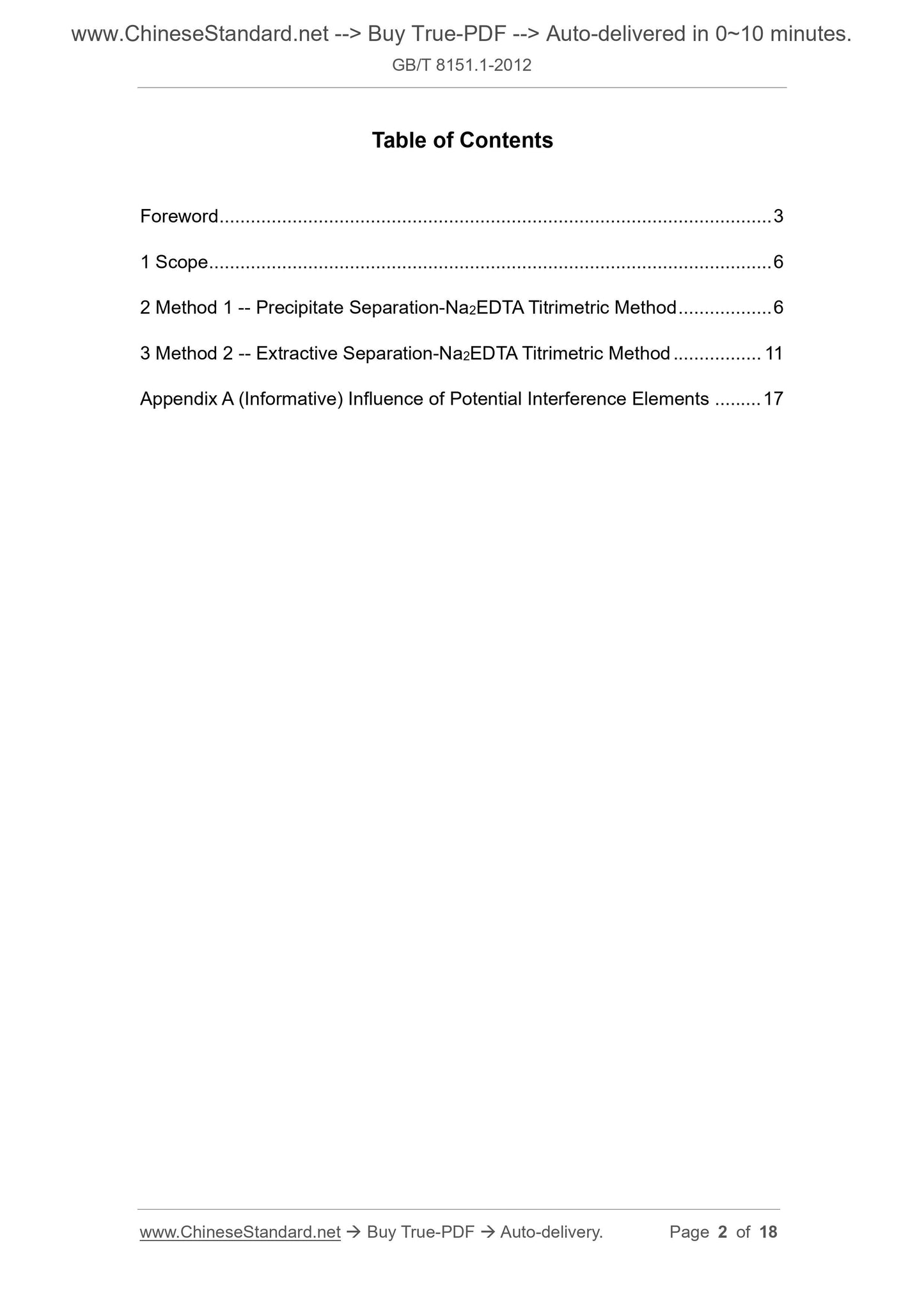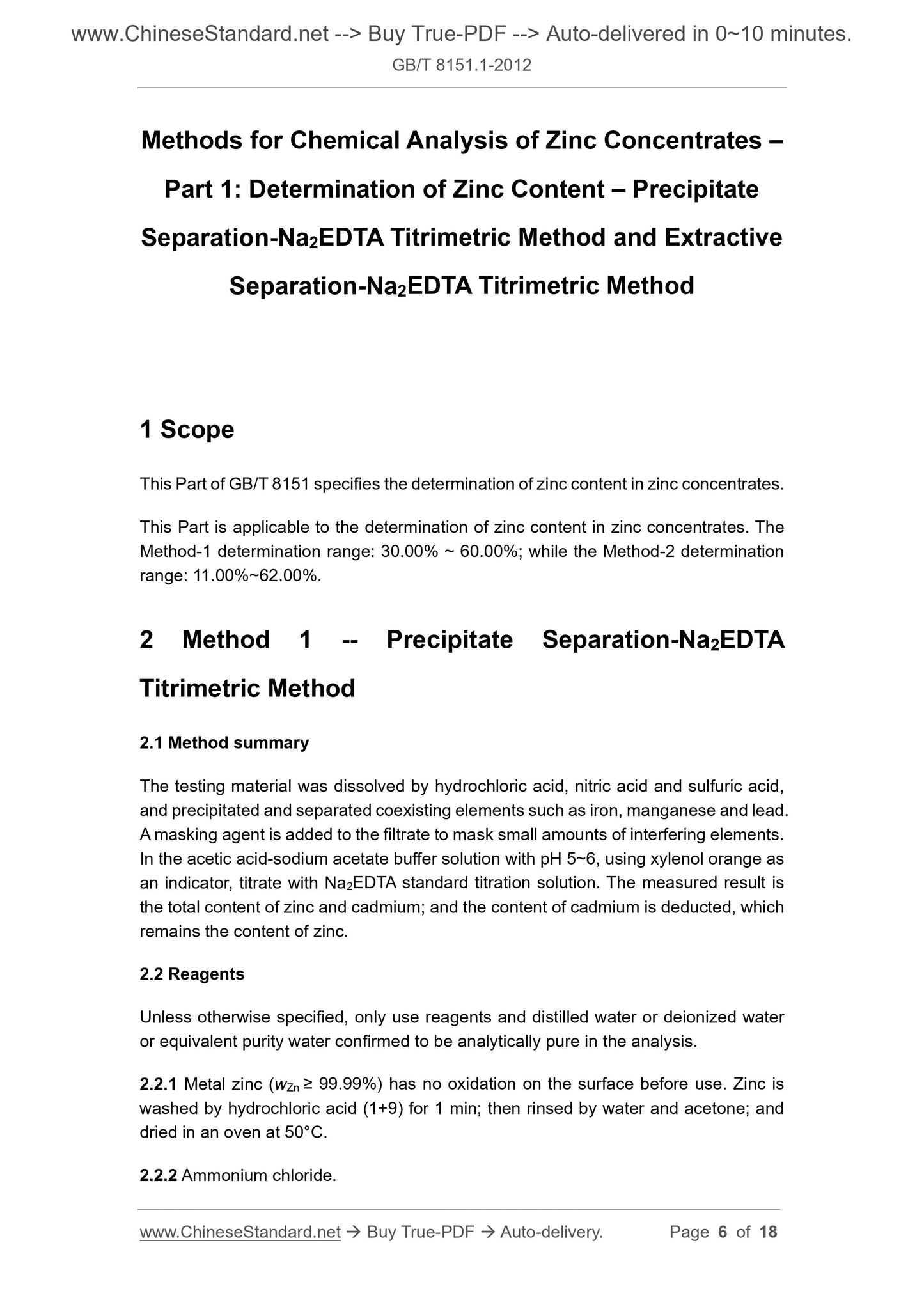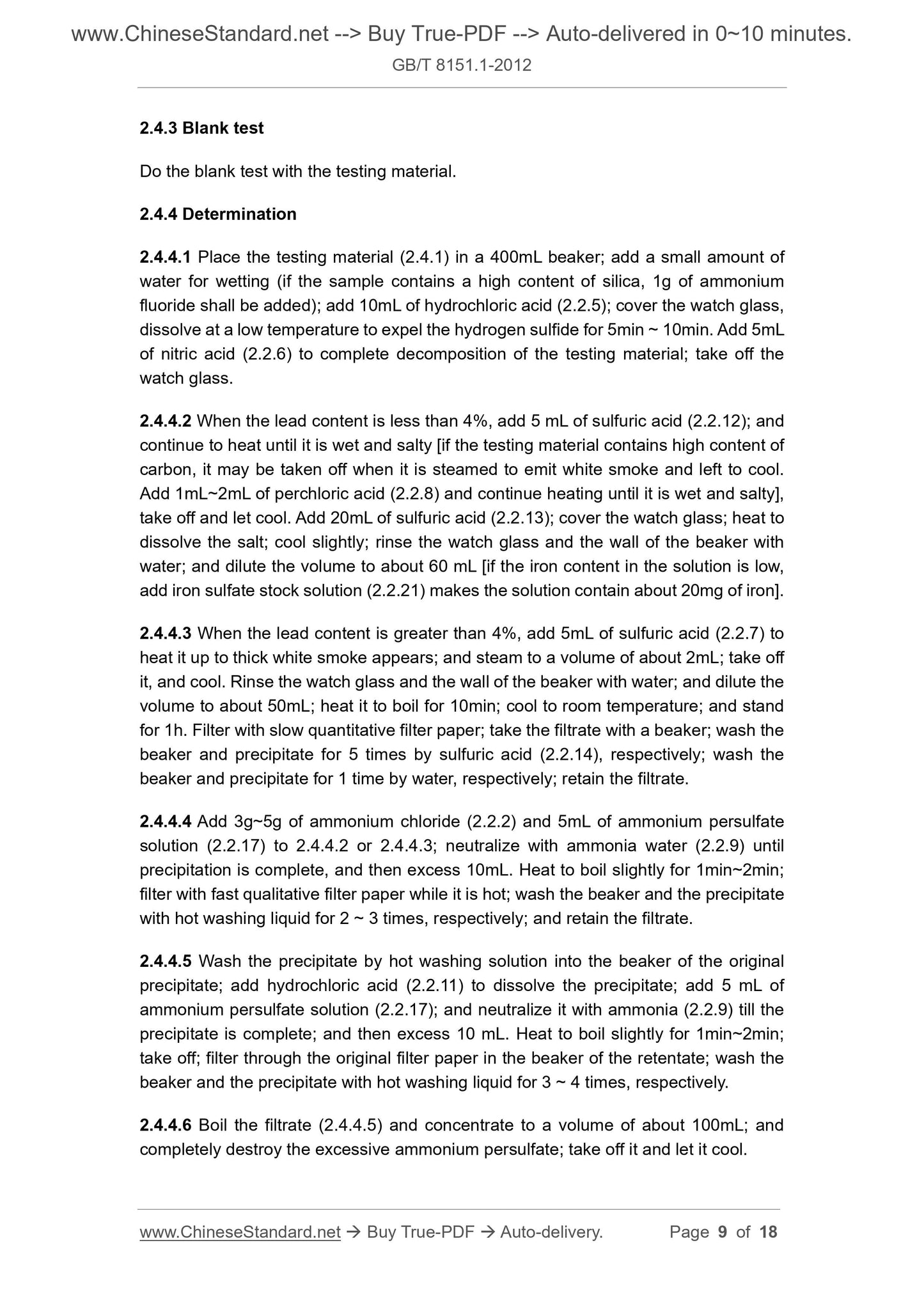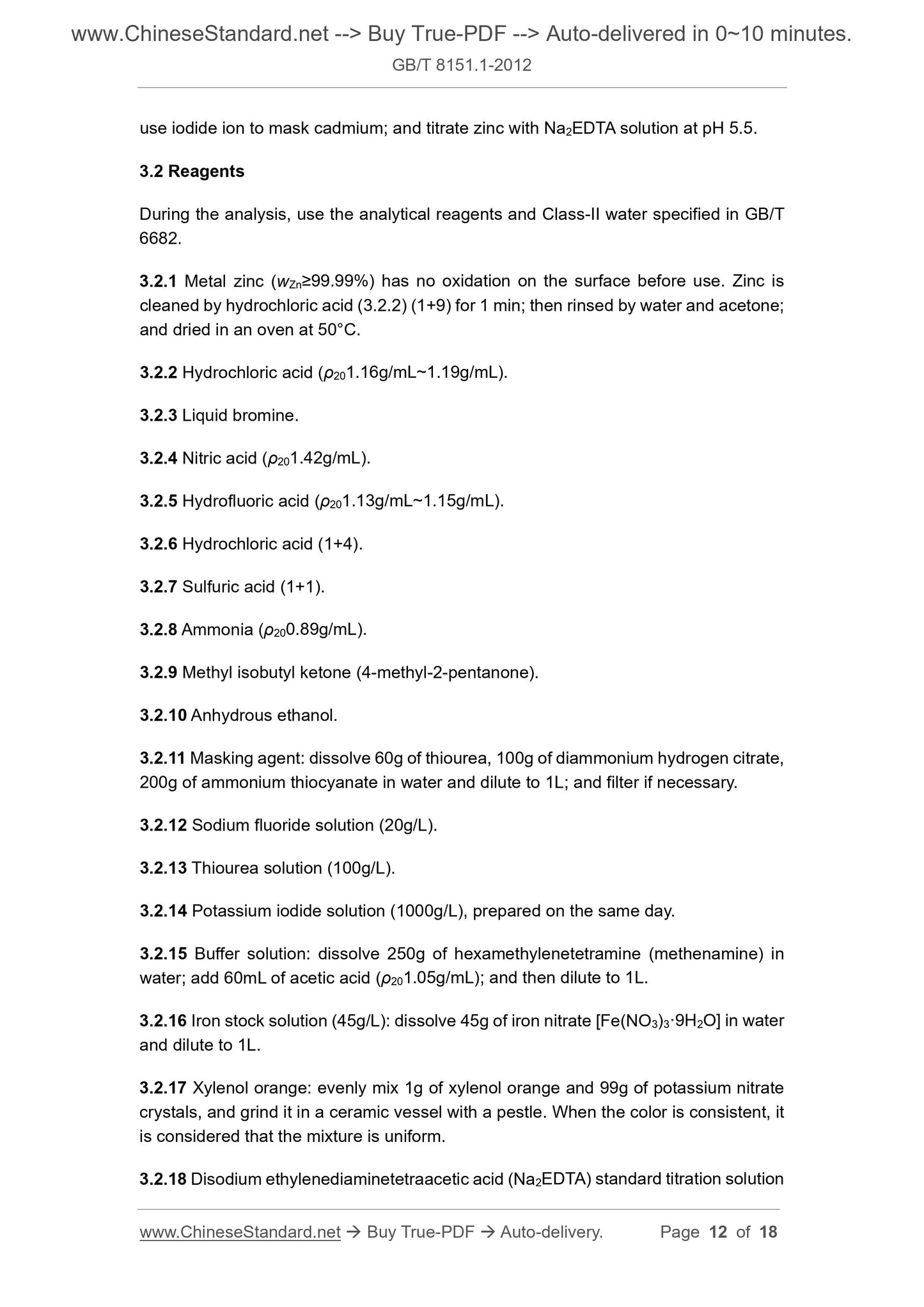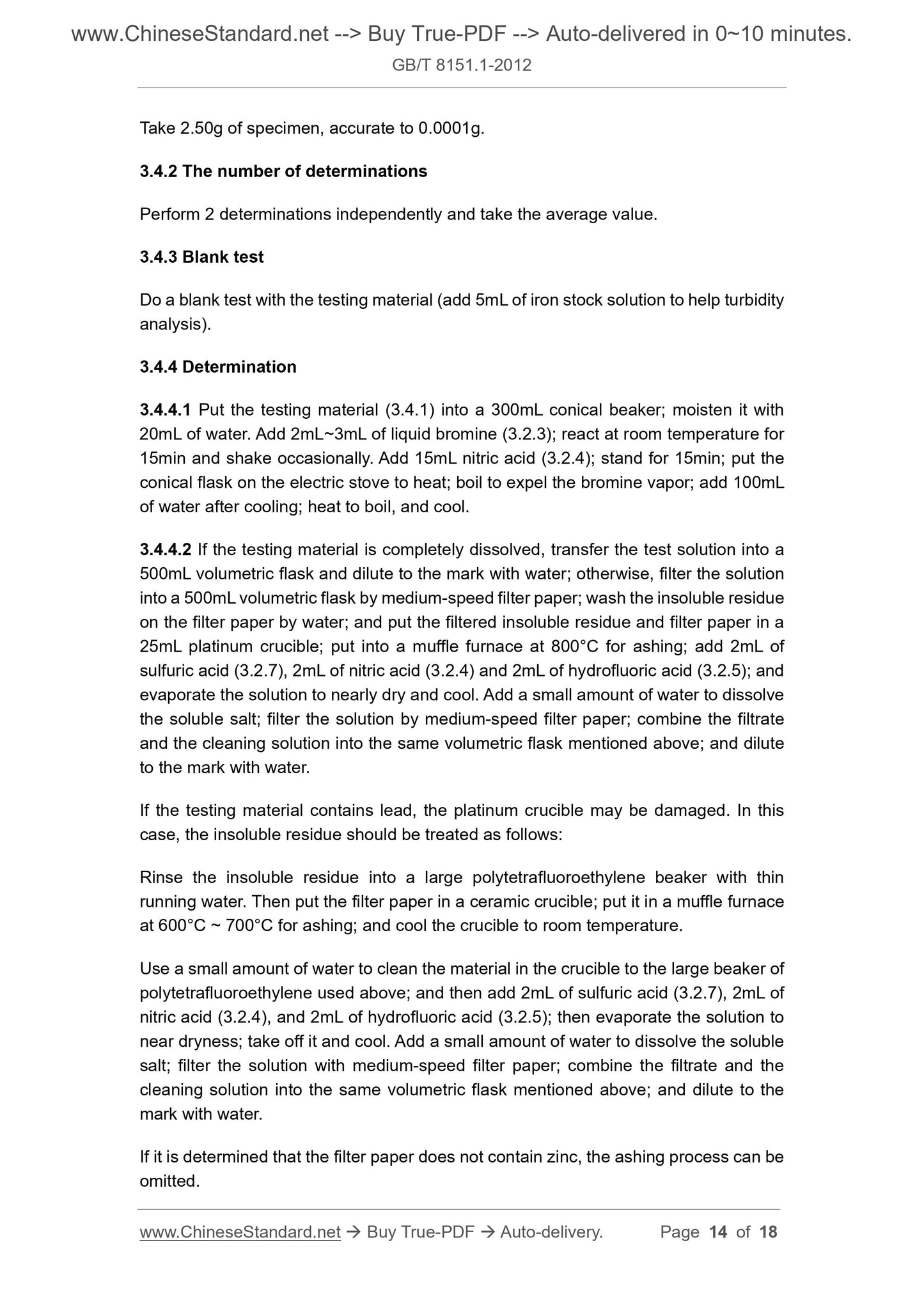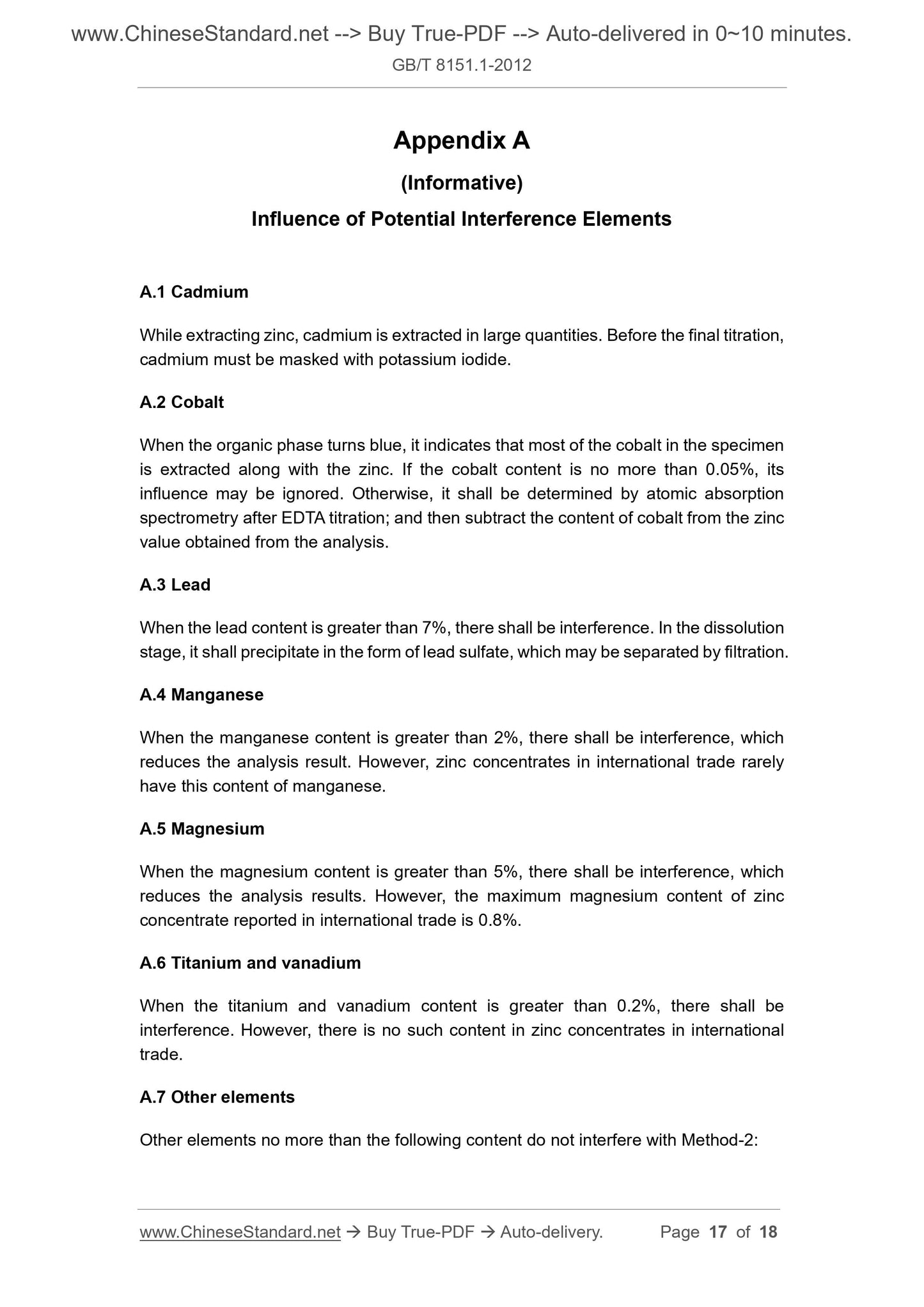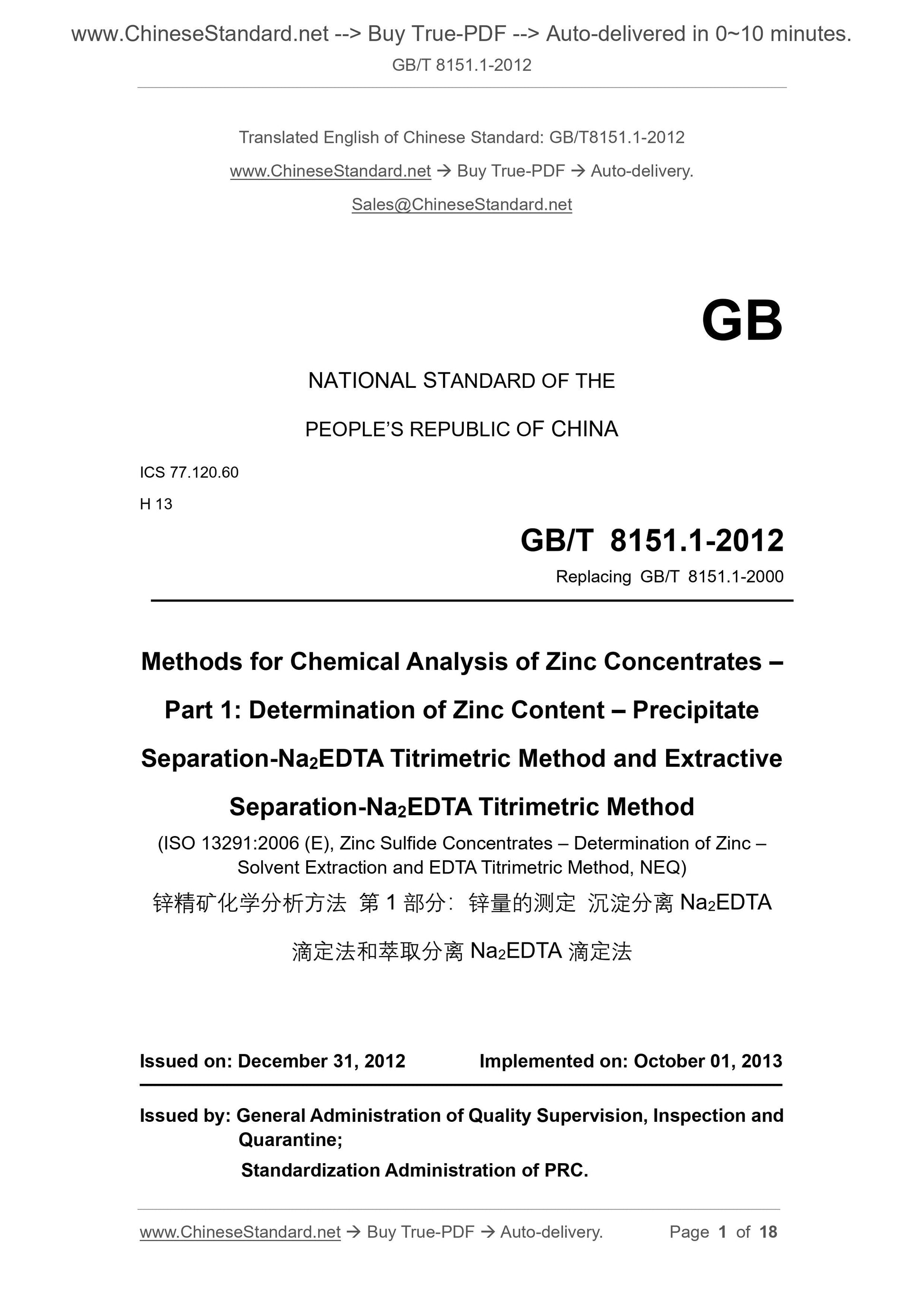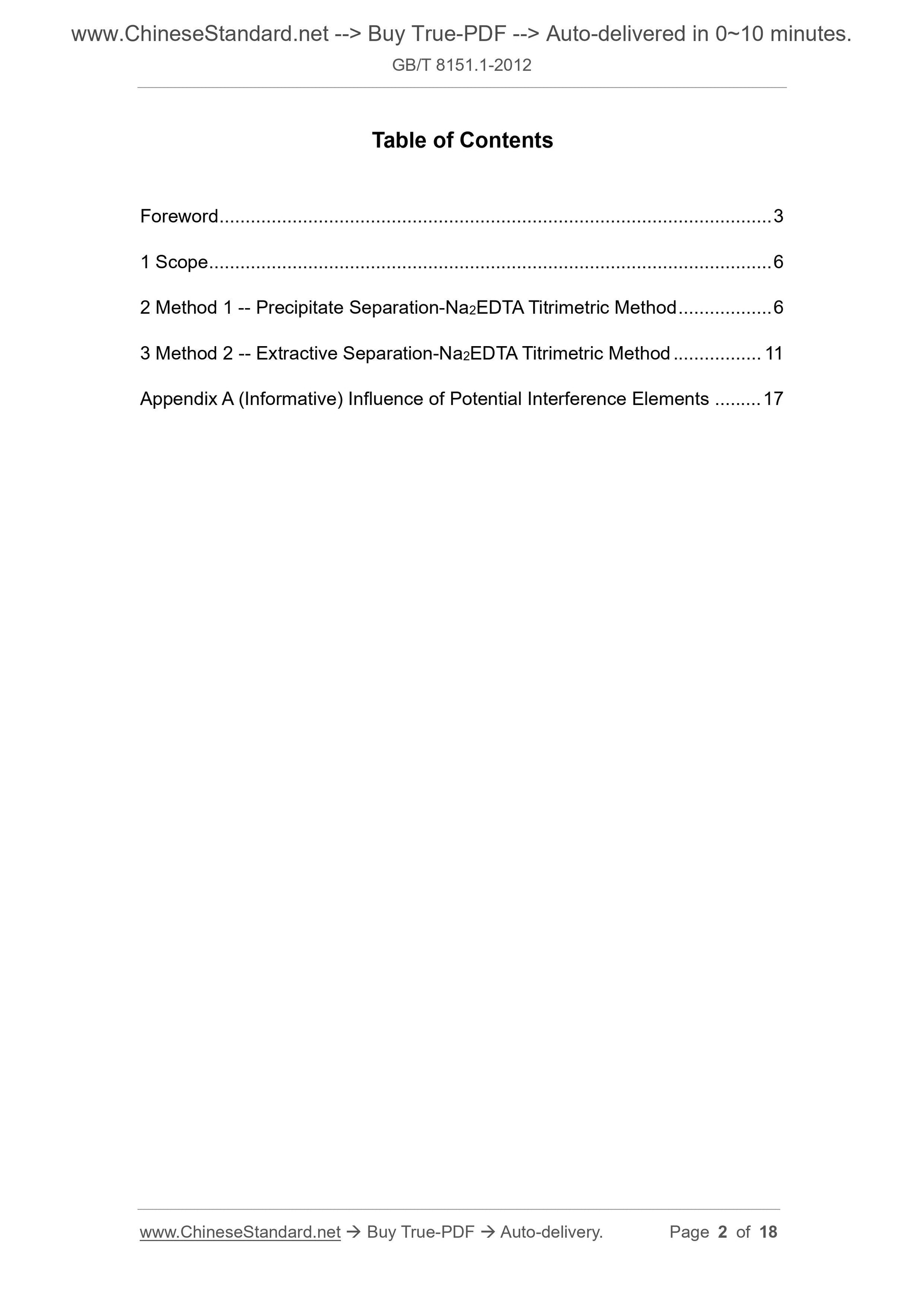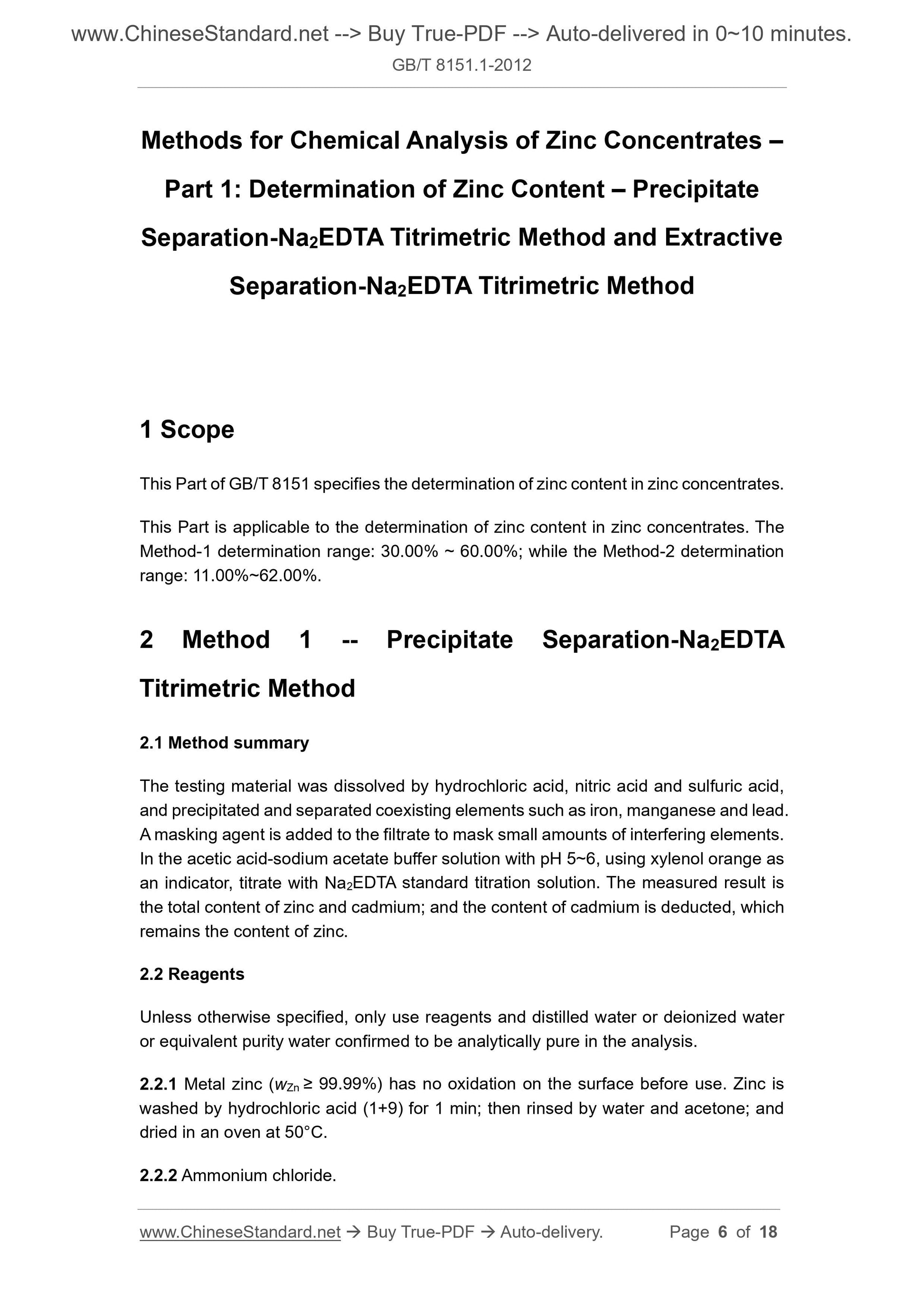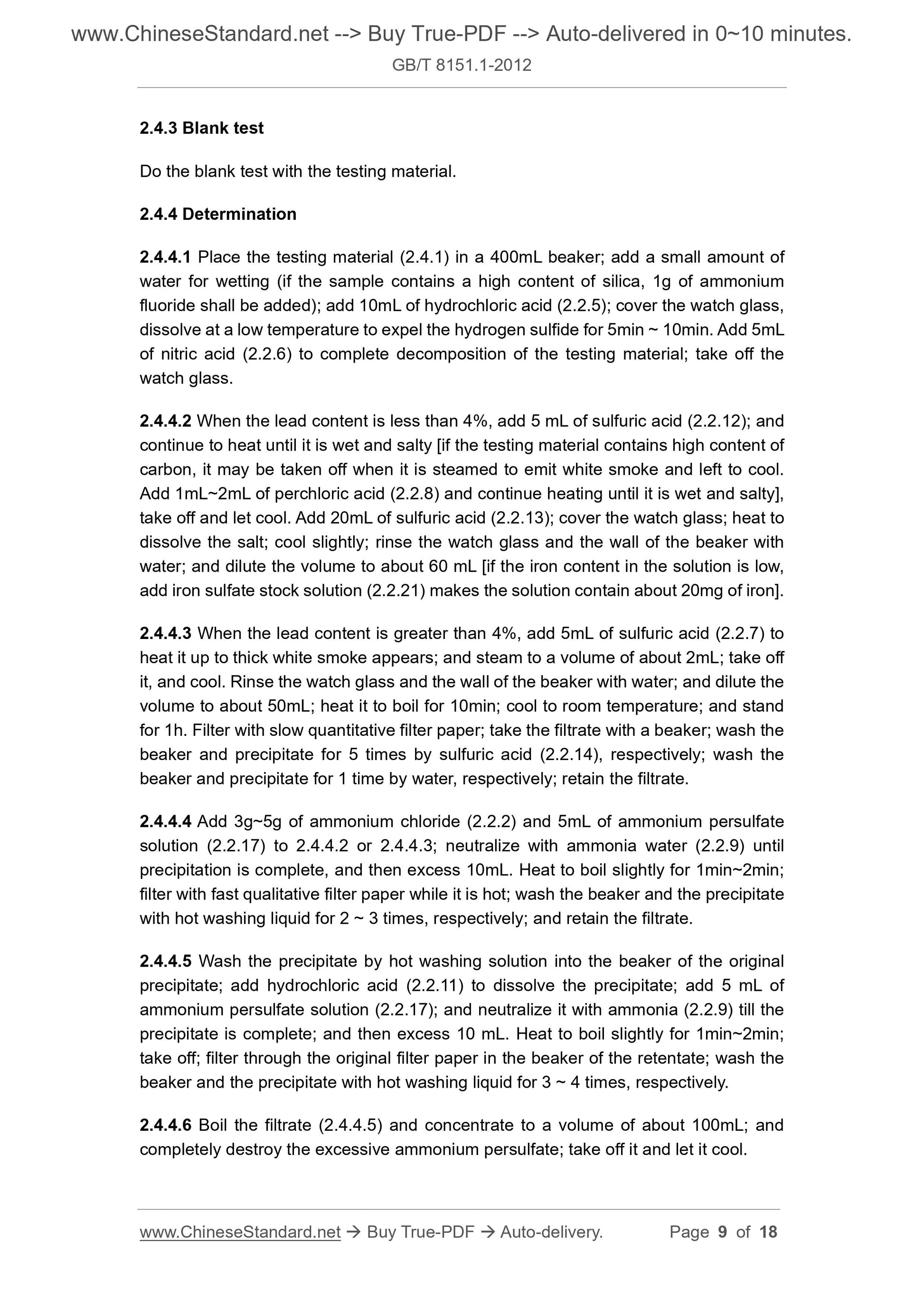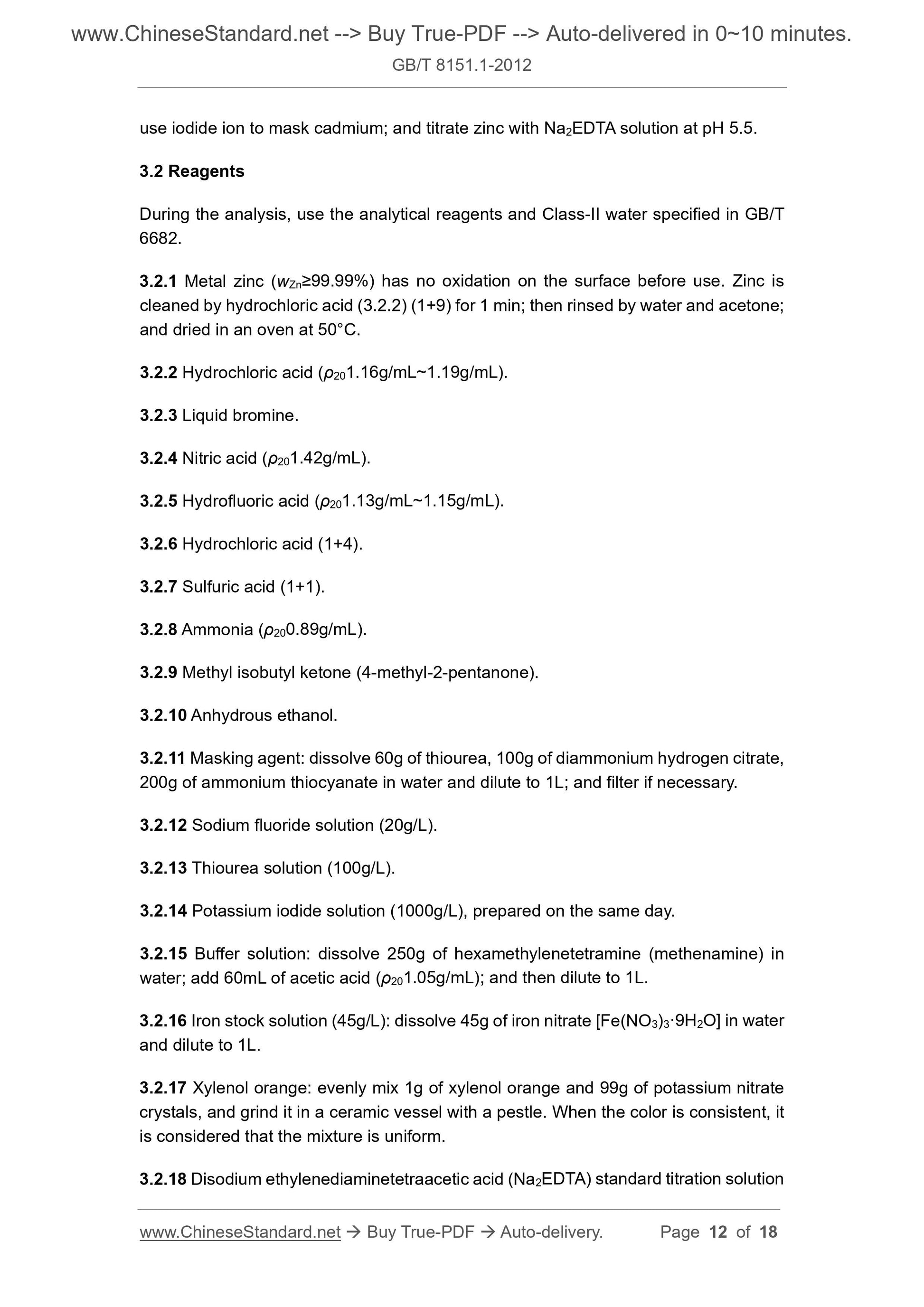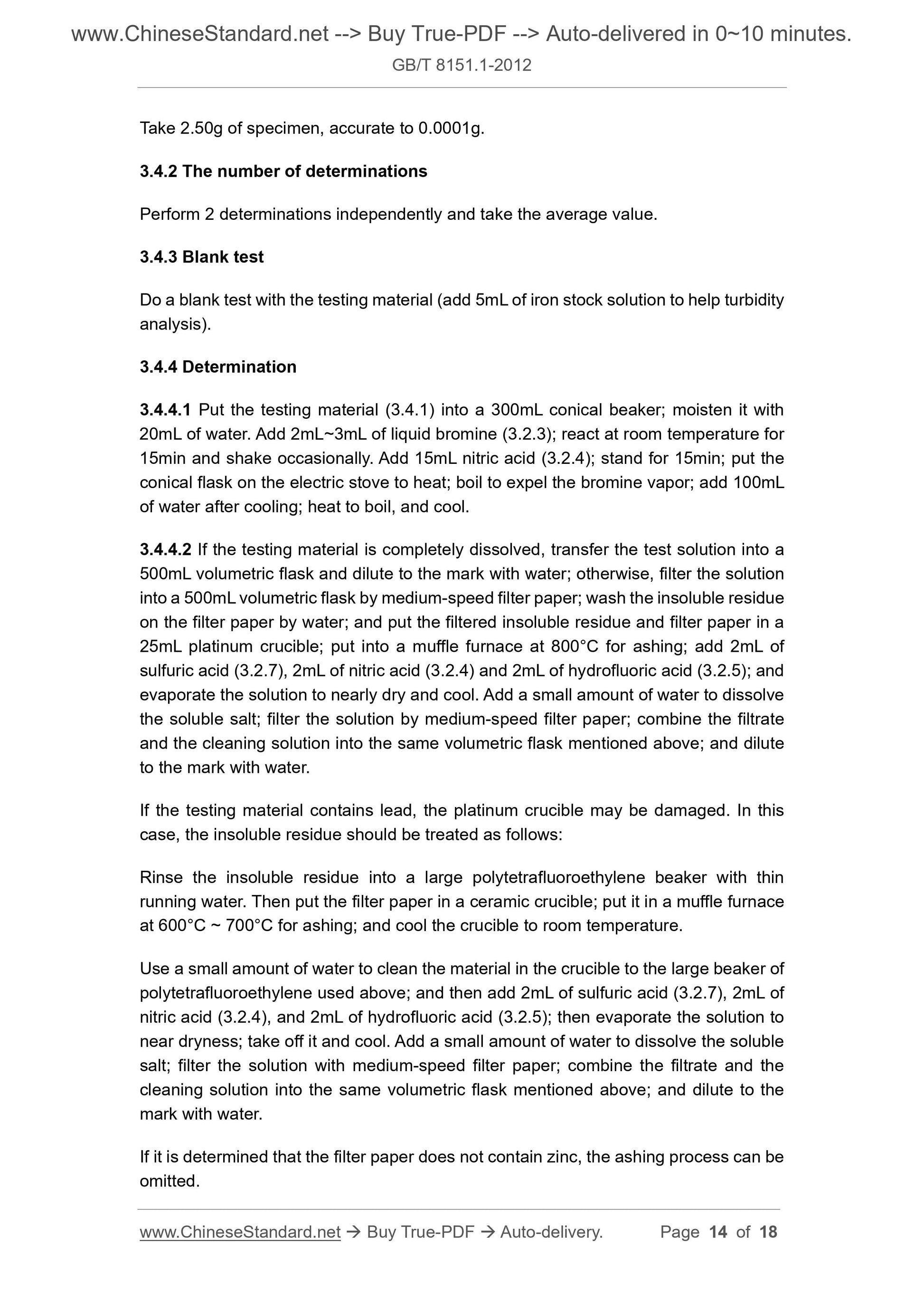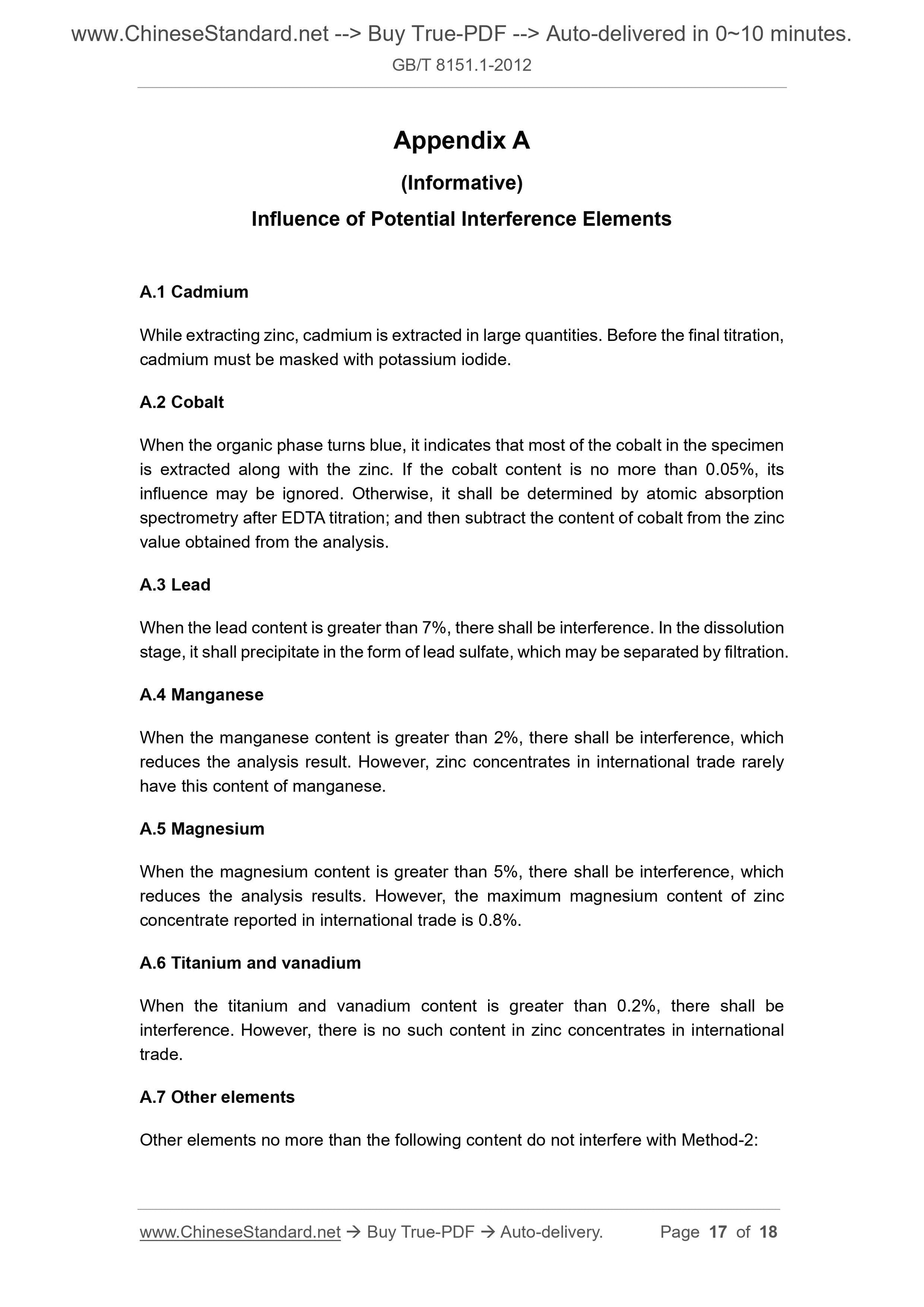1
/
of
7
PayPal, credit cards. Download editable-PDF and invoice in 1 second!
GB/T 8151.1-2012 English PDF (GBT8151.1-2012)
GB/T 8151.1-2012 English PDF (GBT8151.1-2012)
Regular price
$170.00 USD
Regular price
Sale price
$170.00 USD
Unit price
/
per
Shipping calculated at checkout.
Couldn't load pickup availability
Delivery: 3 seconds. Download true-PDF + Invoice.
Get QUOTATION in 1-minute: Click GB/T 8151.1-2012
Historical versions: GB/T 8151.1-2012
Preview True-PDF (Reload/Scroll if blank)
GB/T 8151.1-2012: Methods for chemical analysis of zinc concentrates -- Part 1: Determination of zinc content -- Precipitate separation-Na2EDTA titrimetric method and extractive separation -- Na2EDTA titrimetric method
GB/T 8151.1-2012
GB
NATIONAL STANDARD OF THE
PEOPLE’S REPUBLIC OF CHINA
ICS 77.120.60
H 13
Replacing GB/T 8151.1-2000
Methods for Chemical Analysis of Zinc Concentrates –
Part 1: Determination of Zinc Content – Precipitate
Separation-Na2EDTA Titrimetric Method and Extractive
Separation-Na2EDTA Titrimetric Method
(ISO 13291:2006 (E), Zinc Sulfide Concentrates – Determination of Zinc –
Solvent Extraction and EDTA Titrimetric Method, NEQ)
ISSUED ON: DECEMBER 31, 2012
IMPLEMENTED ON: OCTOBER 01, 2013
Issued by: General Administration of Quality Supervision, Inspection and
Quarantine;
Standardization Administration of PRC.
Table of Contents
Foreword ... 3
1 Scope ... 6
2 Method 1 -- Precipitate Separation-Na2EDTA Titrimetric Method ... 6
3 Method 2 -- Extractive Separation-Na2EDTA Titrimetric Method ... 11
Appendix A (Informative) Influence of Potential Interference Elements ... 17
Methods for Chemical Analysis of Zinc Concentrates –
Part 1: Determination of Zinc Content – Precipitate
Separation-Na2EDTA Titrimetric Method and Extractive
Separation-Na2EDTA Titrimetric Method
1 Scope
This Part of GB/T 8151 specifies the determination of zinc content in zinc concentrates.
This Part is applicable to the determination of zinc content in zinc concentrates. The
Method-1 determination range: 30.00% ~ 60.00%; while the Method-2 determination
range: 11.00%~62.00%.
2 Method 1 -- Precipitate Separation-Na2EDTA
Titrimetric Method
2.1 Method summary
The testing material was dissolved by hydrochloric acid, nitric acid and sulfuric acid,
and precipitated and separated coexisting elements such as iron, manganese and lead.
A masking agent is added to the filtrate to mask small amounts of interfering elements.
In the acetic acid-sodium acetate buffer solution with pH 5~6, using xylenol orange as
an indicator, titrate with Na2EDTA standard titration solution. The measured result is
the total content of zinc and cadmium; and the content of cadmium is deducted, which
remains the content of zinc.
2.2 Reagents
Unless otherwise specified, only use reagents and distilled water or deionized water
or equivalent purity water confirmed to be analytically pure in the analysis.
2.2.1 Metal zinc (wZn ≥ 99.99%) has no oxidation on the surface before use. Zinc is
washed by hydrochloric acid (1+9) for 1 min; then rinsed by water and acetone; and
dried in an oven at 50°C.
2.2.2 Ammonium chloride.
2.4.3 Blank test
Do the blank test with the testing material.
2.4.4 Determination
2.4.4.1 Place the testing material (2.4.1) in a 400mL beaker; add a small amount of
water for wetting (if the sample contains a high content of silica, 1g of ammonium
fluoride shall be added); add 10mL of hydrochloric acid (2.2.5); cover the watch glass,
dissolve at a low temperature to expel the hydrogen sulfide for 5min ~ 10min. Add 5mL
of nitric acid (2.2.6) to complete decomposition of the testing material; take off the
watch glass.
2.4.4.2 When the lead content is less than 4%, add 5 mL of sulfuric acid (2.2.12); and
continue to heat until it is wet and salty [if the testing material contains high content of
carbon, it may be taken off when it is steamed to emit white smoke and left to cool.
Add 1mL~2mL of perchloric acid (2.2.8) and continue heating until it is wet and salty],
take off and let cool. Add 20mL of sulfuric acid (2.2.13); cover the watch glass; heat to
dissolve the salt; cool slightly; rinse the watch glass and the wall of the beaker with
water; and dilute the volume to about 60 mL [if the iron content in the solution is low,
add iron sulfate stock solution (2.2.21) makes the solution contain about 20mg of iron].
2.4.4.3 When the lead content is greater than 4%, add 5mL of sulfuric acid (2.2.7) to
heat it up to thick white smoke appears; and steam to a volume of about 2mL; take off
it, and cool. Rinse the watch glass and the wall of the beaker with water; and dilute the
volume to about 50mL; heat it to boil for 10min; cool to room temperature; and stand
for 1h. Filter with slow quantitative filter paper; take the filtrate with a beaker; wash the
beaker and precipitate for 5 times by sulfuric acid (2.2.14), respectively; wash the
beaker and precipitate for 1 time by water, respectively; retain the filtrate.
2.4.4.4 Add 3g~5g of ammonium chloride (2.2.2) and 5mL of ammonium persulfate
solution (2.2.17) to 2.4.4.2 or 2.4.4.3; neutralize with ammonia water (2.2.9) until
precipitation is complete, and then excess 10mL. Heat to boil slightly for 1min~2min;
filter with fast qualitative filter paper while it is hot; wash the beaker and the precipitate
with hot washing liquid for 2 ~ 3 times, respectively; and retain the filtrate.
2.4.4.5 Wash the precipitate by hot washing solution into the beaker of the original
precipitate; add hydrochloric acid (2.2.11) to dissolve the precipitate; add 5 mL of
ammonium persulfate solution (2.2.17); and neutralize it with ammonia (2.2.9) till the
precipitate is complete; and then excess 10 mL. Heat to boil slightly for 1min~2min;
take off; filter through the original filter paper in the beaker of the retentate; wash the
beaker and the precipitate with hot washing liquid for 3 ~ 4 times, respectively.
2.4.4.6 Boil the filtrate (2.4.4.5) and concentrate to a volume of about 100mL; and
completely destroy the excessive ammonium persulfate; take off it and let it cool.
use iodide ion to mask cadmium; and titrate zinc with Na2EDTA solution at pH 5.5.
3.2 Reagents
During the analysis, use the analytical reagents and Class-II water specified in GB/T
6682.
3.2.1 Metal zinc (wZn≥99.99%) has no oxidation on the surface before use. Zinc is
cleaned by hydrochloric acid (3.2.2) (1+9) for 1 min; then rinsed by water and acetone;
and dried in an oven at 50°C.
3.2.2 Hydrochloric acid (ρ201.16g/mL~1.19g/mL).
3.2.3 Liquid bromine.
3.2.4 Nitric acid (ρ201.42g/mL).
3.2.5 Hydrofluoric acid (ρ201.13g/mL~1.15g/mL).
3.2.6 Hydrochloric acid (1+4).
3.2.7 Sulfuric acid (1+1).
3.2.8 Ammonia (ρ200.89g/mL).
3.2.9 Methyl isobutyl ketone (4-methyl-2-pentanone).
3.2.10 Anhydrous ethanol.
3.2.11 Masking agent: dissolve 60g of thiourea, 100g of diammonium hydrogen citrate,
200g of ammonium thiocyanate in water and dilute to 1L; and filter if necessary.
3.2.12 Sodium fluoride solution (20g/L).
3.2.13 Thiourea solution (100g/L).
3.2.14 Potassium iodide solution (1000g/L), prepared on the same day.
3.2.15 Buffer solution: dissolve 250g of hexamethylenetetramine (methenamine) in
water; add 60mL of acetic acid (ρ201.05g/mL); and then dilute to 1L.
3.2.16 Iron stock solution (45g/L): dissolve 45g of iron nitrate [Fe(NO3)3·9H2O] in water
and dilute to 1L.
3.2.17 Xylenol orange: evenly mix 1g of xylenol orange and 99g of potassium nitrate
crystals, and grind it in a ceramic vessel with a pestle. When the color is consistent, it
is considered that the mixture is uniform.
3.2.18 Disodium ethylenediaminetetraacetic acid (Na2EDTA) standard titration solution
Take 2.50g of specimen, accurate to 0.0001g.
3.4.2 The number of determinations
Perform 2 determinations independently and take the average value.
3.4.3 Blank test
Do a blank test with the testing material (add 5mL of iron stock solution to help turbidity
analysis).
3.4.4 Determination
3.4.4.1 Put the testing material (3.4.1) into a 300mL conical beaker; moisten it with
20mL of water. Add 2mL~3mL of liquid bromine (3.2.3); react at room temperature for
Get QUOTATION in 1-minute: Click GB/T 8151.1-2012
Historical versions: GB/T 8151.1-2012
Preview True-PDF (Reload/Scroll if blank)
GB/T 8151.1-2012: Methods for chemical analysis of zinc concentrates -- Part 1: Determination of zinc content -- Precipitate separation-Na2EDTA titrimetric method and extractive separation -- Na2EDTA titrimetric method
GB/T 8151.1-2012
GB
NATIONAL STANDARD OF THE
PEOPLE’S REPUBLIC OF CHINA
ICS 77.120.60
H 13
Replacing GB/T 8151.1-2000
Methods for Chemical Analysis of Zinc Concentrates –
Part 1: Determination of Zinc Content – Precipitate
Separation-Na2EDTA Titrimetric Method and Extractive
Separation-Na2EDTA Titrimetric Method
(ISO 13291:2006 (E), Zinc Sulfide Concentrates – Determination of Zinc –
Solvent Extraction and EDTA Titrimetric Method, NEQ)
ISSUED ON: DECEMBER 31, 2012
IMPLEMENTED ON: OCTOBER 01, 2013
Issued by: General Administration of Quality Supervision, Inspection and
Quarantine;
Standardization Administration of PRC.
Table of Contents
Foreword ... 3
1 Scope ... 6
2 Method 1 -- Precipitate Separation-Na2EDTA Titrimetric Method ... 6
3 Method 2 -- Extractive Separation-Na2EDTA Titrimetric Method ... 11
Appendix A (Informative) Influence of Potential Interference Elements ... 17
Methods for Chemical Analysis of Zinc Concentrates –
Part 1: Determination of Zinc Content – Precipitate
Separation-Na2EDTA Titrimetric Method and Extractive
Separation-Na2EDTA Titrimetric Method
1 Scope
This Part of GB/T 8151 specifies the determination of zinc content in zinc concentrates.
This Part is applicable to the determination of zinc content in zinc concentrates. The
Method-1 determination range: 30.00% ~ 60.00%; while the Method-2 determination
range: 11.00%~62.00%.
2 Method 1 -- Precipitate Separation-Na2EDTA
Titrimetric Method
2.1 Method summary
The testing material was dissolved by hydrochloric acid, nitric acid and sulfuric acid,
and precipitated and separated coexisting elements such as iron, manganese and lead.
A masking agent is added to the filtrate to mask small amounts of interfering elements.
In the acetic acid-sodium acetate buffer solution with pH 5~6, using xylenol orange as
an indicator, titrate with Na2EDTA standard titration solution. The measured result is
the total content of zinc and cadmium; and the content of cadmium is deducted, which
remains the content of zinc.
2.2 Reagents
Unless otherwise specified, only use reagents and distilled water or deionized water
or equivalent purity water confirmed to be analytically pure in the analysis.
2.2.1 Metal zinc (wZn ≥ 99.99%) has no oxidation on the surface before use. Zinc is
washed by hydrochloric acid (1+9) for 1 min; then rinsed by water and acetone; and
dried in an oven at 50°C.
2.2.2 Ammonium chloride.
2.4.3 Blank test
Do the blank test with the testing material.
2.4.4 Determination
2.4.4.1 Place the testing material (2.4.1) in a 400mL beaker; add a small amount of
water for wetting (if the sample contains a high content of silica, 1g of ammonium
fluoride shall be added); add 10mL of hydrochloric acid (2.2.5); cover the watch glass,
dissolve at a low temperature to expel the hydrogen sulfide for 5min ~ 10min. Add 5mL
of nitric acid (2.2.6) to complete decomposition of the testing material; take off the
watch glass.
2.4.4.2 When the lead content is less than 4%, add 5 mL of sulfuric acid (2.2.12); and
continue to heat until it is wet and salty [if the testing material contains high content of
carbon, it may be taken off when it is steamed to emit white smoke and left to cool.
Add 1mL~2mL of perchloric acid (2.2.8) and continue heating until it is wet and salty],
take off and let cool. Add 20mL of sulfuric acid (2.2.13); cover the watch glass; heat to
dissolve the salt; cool slightly; rinse the watch glass and the wall of the beaker with
water; and dilute the volume to about 60 mL [if the iron content in the solution is low,
add iron sulfate stock solution (2.2.21) makes the solution contain about 20mg of iron].
2.4.4.3 When the lead content is greater than 4%, add 5mL of sulfuric acid (2.2.7) to
heat it up to thick white smoke appears; and steam to a volume of about 2mL; take off
it, and cool. Rinse the watch glass and the wall of the beaker with water; and dilute the
volume to about 50mL; heat it to boil for 10min; cool to room temperature; and stand
for 1h. Filter with slow quantitative filter paper; take the filtrate with a beaker; wash the
beaker and precipitate for 5 times by sulfuric acid (2.2.14), respectively; wash the
beaker and precipitate for 1 time by water, respectively; retain the filtrate.
2.4.4.4 Add 3g~5g of ammonium chloride (2.2.2) and 5mL of ammonium persulfate
solution (2.2.17) to 2.4.4.2 or 2.4.4.3; neutralize with ammonia water (2.2.9) until
precipitation is complete, and then excess 10mL. Heat to boil slightly for 1min~2min;
filter with fast qualitative filter paper while it is hot; wash the beaker and the precipitate
with hot washing liquid for 2 ~ 3 times, respectively; and retain the filtrate.
2.4.4.5 Wash the precipitate by hot washing solution into the beaker of the original
precipitate; add hydrochloric acid (2.2.11) to dissolve the precipitate; add 5 mL of
ammonium persulfate solution (2.2.17); and neutralize it with ammonia (2.2.9) till the
precipitate is complete; and then excess 10 mL. Heat to boil slightly for 1min~2min;
take off; filter through the original filter paper in the beaker of the retentate; wash the
beaker and the precipitate with hot washing liquid for 3 ~ 4 times, respectively.
2.4.4.6 Boil the filtrate (2.4.4.5) and concentrate to a volume of about 100mL; and
completely destroy the excessive ammonium persulfate; take off it and let it cool.
use iodide ion to mask cadmium; and titrate zinc with Na2EDTA solution at pH 5.5.
3.2 Reagents
During the analysis, use the analytical reagents and Class-II water specified in GB/T
6682.
3.2.1 Metal zinc (wZn≥99.99%) has no oxidation on the surface before use. Zinc is
cleaned by hydrochloric acid (3.2.2) (1+9) for 1 min; then rinsed by water and acetone;
and dried in an oven at 50°C.
3.2.2 Hydrochloric acid (ρ201.16g/mL~1.19g/mL).
3.2.3 Liquid bromine.
3.2.4 Nitric acid (ρ201.42g/mL).
3.2.5 Hydrofluoric acid (ρ201.13g/mL~1.15g/mL).
3.2.6 Hydrochloric acid (1+4).
3.2.7 Sulfuric acid (1+1).
3.2.8 Ammonia (ρ200.89g/mL).
3.2.9 Methyl isobutyl ketone (4-methyl-2-pentanone).
3.2.10 Anhydrous ethanol.
3.2.11 Masking agent: dissolve 60g of thiourea, 100g of diammonium hydrogen citrate,
200g of ammonium thiocyanate in water and dilute to 1L; and filter if necessary.
3.2.12 Sodium fluoride solution (20g/L).
3.2.13 Thiourea solution (100g/L).
3.2.14 Potassium iodide solution (1000g/L), prepared on the same day.
3.2.15 Buffer solution: dissolve 250g of hexamethylenetetramine (methenamine) in
water; add 60mL of acetic acid (ρ201.05g/mL); and then dilute to 1L.
3.2.16 Iron stock solution (45g/L): dissolve 45g of iron nitrate [Fe(NO3)3·9H2O] in water
and dilute to 1L.
3.2.17 Xylenol orange: evenly mix 1g of xylenol orange and 99g of potassium nitrate
crystals, and grind it in a ceramic vessel with a pestle. When the color is consistent, it
is considered that the mixture is uniform.
3.2.18 Disodium ethylenediaminetetraacetic acid (Na2EDTA) standard titration solution
Take 2.50g of specimen, accurate to 0.0001g.
3.4.2 The number of determinations
Perform 2 determinations independently and take the average value.
3.4.3 Blank test
Do a blank test with the testing material (add 5mL of iron stock solution to help turbidity
analysis).
3.4.4 Determination
3.4.4.1 Put the testing material (3.4.1) into a 300mL conical beaker; moisten it with
20mL of water. Add 2mL~3mL of liquid bromine (3.2.3); react at room temperature for
Share
